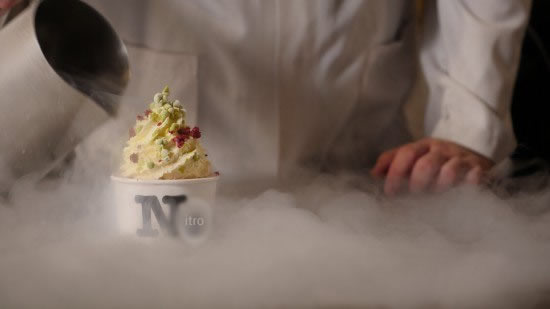LIQUID NITROGEN
Also called Molecular Ice Cream
A Great Innovation in the World of Ice Cream
....
The dangers of ingesting liquid nitrogen
How harmful is it?
Peter Barham, a professor at the University of Bristol's School of Physics, says liquid nitrogen is "simply the least harmful nitrogen gas, cooled to such low temperatures that it becomes a liquid."
.
However, because it is in a liquid state, Barham adds, it is extremely cold and can cause frostbite or cryogenic burns if not used correctly.
Those who work in a laboratory are at risk of suffocation if liquid nitrogen (which is colorless, odorless and tasteless) is used or spilled in an enclosed space. In 1999, for example, laboratory technician James Graham died of asphyxiation.
Furthermore, liquid nitrogen expands greatly when evaporated. One litre of liquid nitrogen can result in 700 litres of gas, so only a small volume of liquid nitrogen needs to evaporate in a closed room for oxygen deficiency to occur in the atmosphere.
Is it worth the risk?
In the kitchen, its use is not a problem as long as the necessary safety measures are taken, says Barnham.
"If liquid nitrogen is added to another liquid such as ice cream, it will cool it faster as the boiling point decreases and produce a cloud of vapour."
"The technique is used by some restaurants to prepare ice cream at the table. By freezing it so quickly, tiny ice crystals are produced in the mixture which gives it a really smooth texture," says Barham.
However, just as no one would drink boiling water or pour it on themselves, no one should ingest liquid nitrogen, he adds.
It is also important that all the liquid is evaporated from food or drink prepared with liquid nitrogen before it is consumed.
John Emsley, science writer and fellow of the Royal Society of Chemistry says that if more than a small amount of liquid nitrogen is consumed, the result could be fatal.
"If you take more than a few drops of liquid nitrogen, it will freeze, turning solid and brittle like glass. Imagine if that happens inside the food pipe of the stomach."
"The liquid also quickly picks up heat, boils and turns into gas; this could cause damage such as punctures or even bursting the stomach," Emsley adds.
However, he says he would be surprised if anyone could ingest that much liquid nitrogen.
"It would feel extremely cold in your mouth, and you would want to spit it out immediately," he says.
In contrast, Alex Valavanis, a researcher at the Microwave and Photonics Institute at the University of Leeds, believes it is feasible that a person could swallow a mouthful before noticing any ill effects, as liquid nitrogen "does not feel immediately cold."
The researcher argues that the delay in the sensation of cold is due to the "Leidenfrost effect", which occurs when a liquid comes into contact with a mass warmer than the boiling point of the liquid, producing a layer of insulating vapor.
But he agrees that a mouthful of liquid nitrogen, equivalent to about 25 litres of gas, could cause "catastrophic damage".
The consequences
Emsley thinks the liquid gas is safe in the hands of top chefs and can also be safely used by a bartender to create sensational effects, but he says there needs to be a "strong warning not to mess around with it".
"It may be a novelty in the hands of experts, but it would be something very different in the hands of the general public".
"If a few drops fall on your fingers, it will immediately boil and the skin will peel off; the finger will probably not suffer as much damage".
"But if you dip your finger in liquid nitrogen, it will turn into a solid rock and fall off", Emsley says.
- https://www.bbc.com/news/magazine-19870668#:~:text=%22The%20liquid%20also%20quickly%20picks,to%20burst%2C%22%20he%20says.






